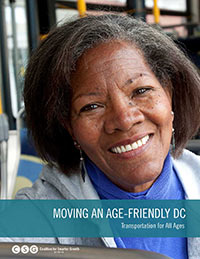AARP Hearing Center
How to provide Washington, D.C.'s, older adults with safe, efficient and affordable transportation is the focus of Moving an Age-Friendly D.C.: Transportation for All Ages, a report published by the Coalition for Smarter Growth in September 2014.
When D.C. joined the AARP Network of Age-Friendly Communities program in 2012, the city's administration thereby pledged to make the District more accessible for its older residents. AARP's initiative aligns with an international effort led by the World Health Organization (WHO), which defines measures in eight domains to promote active aging in urban environments.
The nation's capital is unique and its population diverse. Older adults make up more than 11 percent of its residents, and that number is only expected to grow as D.C.'s boomers age. Many older adults do not live near Metro stations, the report notes, and seniors in the District are the least likely group to own a car. Compared to the states, D.C. has the highest number of older adults living in multifamily homes. An older adult with a disability lives in more than a third of all age 50-plus households in the city.
Many residents desire to age in place, and the District must plan accordingly. Indeed, the number of adults 50-plus who live alone is higher than any state in the U.S. — 30 percent of females (33,000 women) and 20 percent of males (23,000 men). While the report's authors note that D.C. has made positive strides, much work remains to be done to meet the needs of all residents.
The report summarizes best practices, provides an assessment of D.C.'s current efforts and offers recommendations for the following three transportation areas: the pedestrian environment, public transit and alternative transportation services.
Key Points
Targeted toward local policy makers, the report is divided into the following main sections: Understanding the Needs of Older Adults in DC (page 11); The Pedestrian Environment (page 15); Public Transit (page 31) and Alternative Specialized Transportation (page 43). Highlights among the report's recommendations:
- Dedicate adequate funding for sidewalk maintenance and repair to ensure safe streets
- Collect and use data on collisions involving pedestrians and bicyclists to identify high-risk intersections, and make quarterly updates available to the public
- D.C. agencies should collaborate on efforts to increase the number of senior-friendly public amenities, including sidewalk seating, quality lighting and public restrooms
- Encourage the development of affordable age-friendly housing, as well as buildings housing senior services, within one quarter of a mile of public transit
- Secure funding for "Metro Momentum," a strategic plan that will increase transit coverage, accessibility and affordability for older adults and riders with special needs
- Make 100 percent of the bus stops in the District accessible
- Establish a mobility management staff position within an existing office in the District
- Create a one-call/one-click center to help residents find transportation and mobility assistance
- Create incentives for increasing the number of accessible taxis in the District
Don't Miss
- A summary of Washington, D.C.'s, demographics, page 11
- A map that shows D.C.'s adult population over 65 and public transit routes, page 13
- Best practices for an age-friendly pedestrian environment, pages 17-19
- Best practices for age-friendly public transit, pages 33-36
- Details of the Metro Momentum strategic plan, page 38
- Best practices for alternative specialized transportation, pages 45-52
- A case study of establishing a mobility management system in Montgomery County, Maryland, page 50
- A list of specialized transportation services for District seniors and people with disabilities, pages 63-64
The 5 A's of Age-Friendly Transit
Availability: Transit exists and is available when needed
Accessibility: Transit can be reached and used (buses have low-floor boarding, bus seats are high enough, bus stop signage is readable, van comes to the door)
Acceptability: Standards relate to conditions such as cleanliness (bus is not dirty), safety (bus stops are located in safe areas) and user-friendliness (transit operators are courteous and helpful)
Affordability: Fees are affordable, comparable to or cost less than driving a car, and vouchers or coupons help defray out-of-pocket expenses
Adaptability: Transit service can be modified or adjusted to meet special needs and wheelchairs can be accommodated
Report published: September 2014 | Summary by Jessica Ludwig

































































